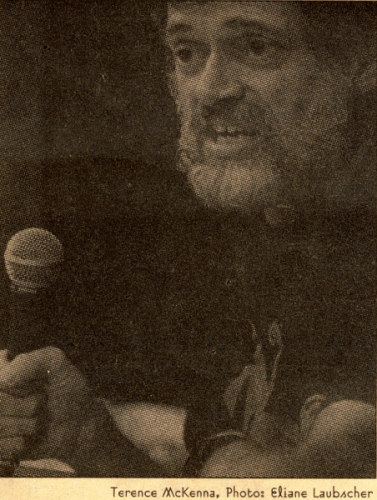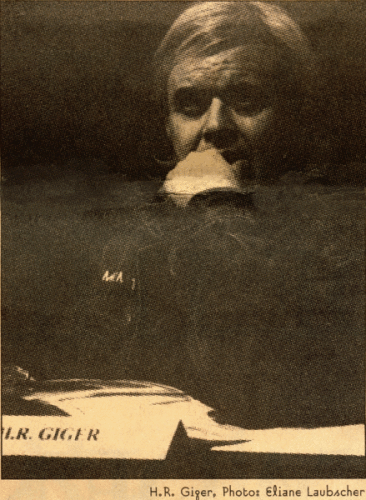The Incident
The Incident symposium in Fribourg, Switzerland in June brought together diverse artists and researchers dealing with non-explicable phenomena. Jacques Vallee discussed UFOs, Budd Hopkins presented his evidence of alien abductions, Rod Dickinson talked about crop circles, Ulrike Rosenbach described her work on angels, drugs guru Terence McKenna enthused about DMT and tried to persuade all the symposium delegates to take it, Jeremy Narby described the paintings of an Amazonian shaman that feature both DNA diagrams and UFOs, Keiko Sei and Kathleen Rogers discussed psychic phenomena and Swiss artist HR Giger showed his work which informed the aesthetic of the Aliens movies. Between them all, whether you subscribed to belief or scepticism on any particular issue, you had to observe that our accepted notions of reality were being severely questioned from all angles. Overall The Incident asked what contribution artists might make to the debates around non-explicable phenomena and raised the notion, as symposium organiser Rob La Frenais commented, that "artists might be better equipped to deal positively with the ambiguous subjectivity that such extensions of perceptivity bring".
American artist, James Turrell's keynote address characterised phenomena researchers and artists as pioneers -akin to the criminals, deviants and delinquents who sailed to the New Worlds in previous centuries - venturing into the unknown that would become the future. As Turrell commented, the brain has capacities for which we have not yet invented a vocabulary. Whatever interpretation you put upon them (military conspiracy ... benign or evil intentioned aliens ... god), there seems to be an overwhelming mass of evidence of physical phenomena that is neither adequately measured or explained by our current sciences. Consciousness, perception and phenomena are now the research subjects of reputable academic institutions around the world including the Universities of Edinburgh, Duke in North Carolina, California and Austin in Texas. La Frenais' contention was that "at the point at which science breaks down, at which results are anomalous or evidence appears to point at non-provable conclusions, artists can take over where rationality stops".

Image: Elaine Laubscher, Terence McKenna
Research into the unconscious, evolution and genetics have radically altered our understanding of ourselves during this last century. The Incident seemed to be laying the ground for the next stage of research into what constitutes the self and consciousness within a universal context. New technologies are extending the body and perception. To some extent our relationship with developing technologies, with cyberspace, is merely contesting old ideologies in a new space, but is there also something evolutionary emerging from our interface with technology, and should we, as David Porush suggested at the Virtual Futures conference in Warwick earlier this year, be "treating the history of communications technology evolution as lying on the vector of evolving telepathy"?
Initially in the symposium there appeared to be a separation and mutual denial going on between two camps - which might flipply be described as the science or "hardware" camp (mainly male) including the UFOlogists, military conspiracy theorists, and technologists, and the psychic, intuitive or "software" camp (mainly female) covering parapsychology, angels, shamanism. But bringing them all together created the possibility to ask some wide ranging questions about where the limits of our perception and our sense of reality are. One could take up a range of possible positions - incline towards a view that the phenomena under discussion are external, and can therefore either be proved to be "real" or hoaxes and sinister government cover-ups, or incline towards a sense that everything was internal and symbolic, enacting processes and needs of human consciousness - but it was impossible to simply dismiss the questions. Some want aliens, angels or ghosts to be superior beings advising and shaping human history - and linked to our ideas of god - others see bogey men abducting us, performing nasty surgery upon us and generally satisfying our need to be traumatised and very afraid, or others regard the debate as the expression of a universal loneliness - a desire to find that we are not alone in our consciousness and our unremitting need for anwers.

Image: Elaine Laubscher, H.R. Giger
Apart from Jeremy Narby's accounts of Amazonian shamanic artists, and three delegates from Mexico, there was a lack of direct contribution from anyone outside white, Western cultures, but an expressed wish to address this in a subsequent event.
The symposium weekend also presented works by artists: "Close Call" - a tardislike installation using neon and strobes by James Turrell, an interactive work by Chen Chih-Cheng, an installation about water consciousness and dowsing by Kathleen Rogers, a performance exploring the possibilities of communicating with the sleeping body through electrical stimulation and amplified skin responses by Bruce Gilchrist and a CD Rom demo by Homer Flynn of The Residents. The symposium was followed by the two week Belluard-Bollwerk Festival on the same theme of non-explicable phenomena with performances by artists including Albert Vidal, Anne Bean and Erik Hobijn.
The Incident symposium papers will be published early next year and a second symposium is currently being planned. For further information contact Rob La Frenais on <75337.206 AT compuserve.com>
Mute Books Orders
For Mute Books distribution contact Anagram Books
contact@anagrambooks.com
For online purchases visit anagrambooks.com






